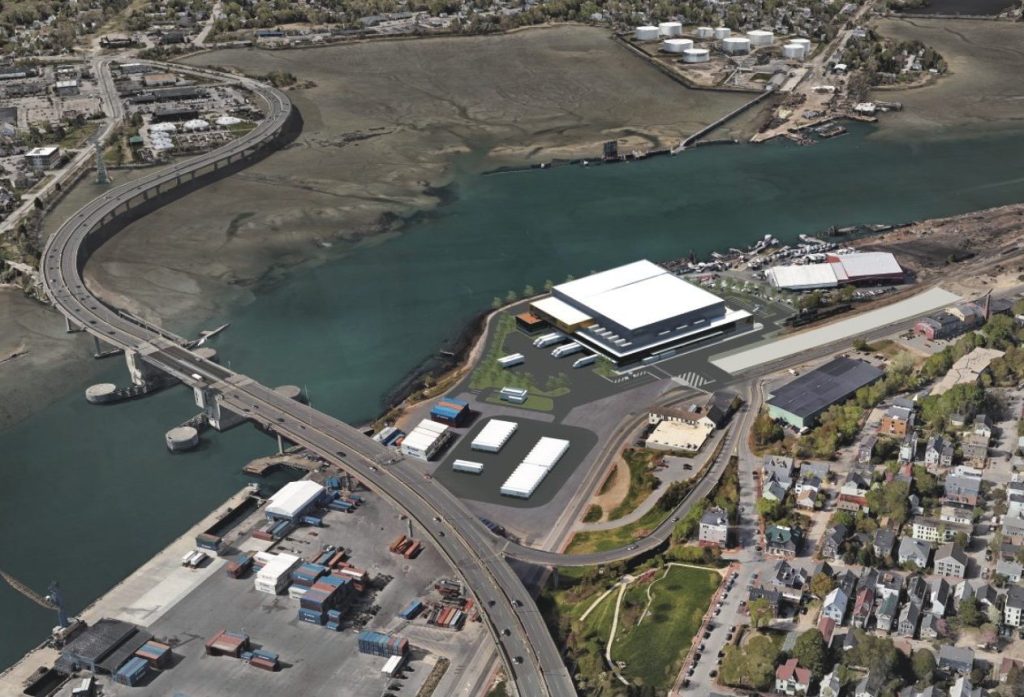The city of Portland gets its name and identity from its sheltered, deep-water harbor, where for hundreds of years people have loaded and unloaded ships, moving cargo up and down the coast and both ways across the Atlantic.
That port activity is the reason the rest of the city exists, and it is the root of all other branches of our economy, influencing growth patterns here and throughout the state. But for such an important part of the city, the actual “port” in Portland takes up very little space.
Right now, the cargo port is the narrow strip of waterfront that curls along the Fore River between the Casco Bay and Veterans Memorial bridges, encompassing the city’s International Marine Terminal and several privately owned parcels. The Planning Board will resume work Thursday night on a zoning amendment that would permit construction at the marine terminal of a 68-foot-tall cold-storage warehouse, 23 feet higher than what would be allowed under current rules.
This is no ordinary zoning change. This is a historic opportunity to modernize the port with private investment that is projected to create hundreds of jobs and generate millions of dollars in economic activity, both directly and through new business growth. But the game-changing potential of this warehouse is drawing neighborhood opposition.
Those concerns should not drive the decision-making process, however. This is not just a series of questions about sight lines, traffic patterns and a single building’s height – it’s also about what kind of city Portland has been and what it will be in the future. If Portland is to remain a port, it needs to make this change.
The port of Portland is in the middle of a period of rapid change that may look sudden, but has been planned for decades.
More than 20 years ago, the western waterfront was set aside for industrial uses. Ten years ago, the state Port Authority took over management of the marine terminal and began directing improvements to the facility, including the extension of a rail line paid for with public money.
In 2014, the work paid off when Eimskip, the Icelandic steamship company, picked Portland as its North American headquarters. The last missing piece in Portland is a cold-storage warehouse, which would allow the port to function as a logistics hub for food and beverage producers large and small.
Because of the volume of business that Eimskip brings to Portland, Americold, the national leader in cold storage, has proposed building a $30 million facility on leased land at the site. To make the project cost-competitive, the company says it needs a 68-foot-tall building (roughly the same height as the Pierce Atwood law firm’s building farther east on Commercial Street).
Residents of the adjacent neighborhoods have objected to the zoning amendment, calling the building “out of scale” for the city and arguing that it would generate too much truck traffic, moving freight that neither arrives nor leaves by ship.
We find the neighbors’ complaints to be well-intentioned, but ultimately shortsighted and selfish.
Portland’s port is already so small that any new structure is going to stick out. There is no way that this industrial zone is ever going to blend in with the residential neighborhoods that look down on it from the Western Promenade, nor should it. The port is unique in the city and can’t be expected to fit in.
And there is no “Plan B.” Even though cold storage has been an identified need since the 1990s, no company has proposed building a smaller facility at this site, because it would not be economically viable.
We have no reason to believe Americold or anyone else would build one now if the zoning change were turned down.
And a greater volume of cargo moving on and off the site by truck should be viewed as a problem to be solved – not avoided. There are much better ways to control Commercial Street traffic (which is mostly caused by commuters) than by preventing the only industrial waterfront zone in the city from generating jobs and economic opportunity.
The Planning Board and City Council should not look at this zoning amendment as a neighborhood issue, or even just a city issue.
This is about whether Portland will continue its historical role as a regional transportation hub, accepting all the benefits and challenges that come with it, or if the city will let this opportunity pass it by, maybe forever.
Copy the Story LinkSend questions/comments to the editors.



Success. Please wait for the page to reload. If the page does not reload within 5 seconds, please refresh the page.
Enter your email and password to access comments.
Hi, to comment on stories you must . This profile is in addition to your subscription and website login.
Already have a commenting profile? .
Invalid username/password.
Please check your email to confirm and complete your registration.
Only subscribers are eligible to post comments. Please subscribe or login first for digital access. Here’s why.
Use the form below to reset your password. When you've submitted your account email, we will send an email with a reset code.